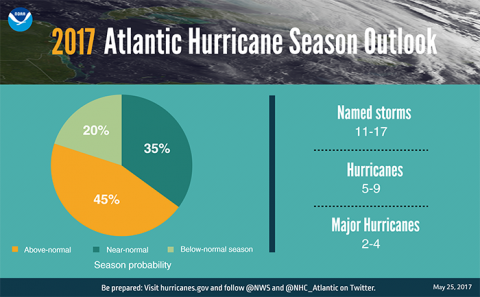
Georgetown, Del. (12 p.m. Thu, May 25, 2017): Sussex County is heading into another summer season, and beach outings, baseball games, and backyard barbeques surely top the list of things to do for many residents and visitors. But there’s one other very important ‘to do’ that should be on everyone’s list, and it could very well save a life.
As the Atlantic hurricane season officially gets underway June 1, the Sussex County Emergency Operations Center reminds residents and visitors to have a plan and be prepared for extreme weather in the months ahead. Preparation is key to limiting damage and preventing loss of life.
“The old adage ‘hope for the best and prepare for the worst’ is what every home owner, business person and visitor should live by, especially during hurricane season,” Sussex County EOC Director Joseph L. Thomas said. “A hurricane or a tropical storm is just a forecast away, regardless of the seasonal outlook. Better to be prepared and not need it than to be caught off guard and risk loss of life.”
June marks the beginning of the six-month-long Atlantic hurricane season, and like other coastal communities from the Caribbean to Canada, Sussex County is susceptible to the effects of tropical weather, from flooding to high winds.
The 2016 hurricane season was above average in the Atlantic, with 15 named storms during the season. Sussex County escaped relatively unscathed, though Tropical Storm Hermine put a damper on the Labor Day weekend as it meandered off the mid-Atlantic coast, threatening to cause significant flooding and wind damage but ultimately weakening and drifting out to sea.
For the 2017 Atlantic hurricane season, the National Oceanic and Atmospheric Administration is predicting more of the same, with 11 to 17 named tropical systems possible. Of those, five to nine could become hurricanes, with up to four of those possibly reaching Category 3 strength or higher, according to NOAA’s May 25 forecast. Forecasters expect a weak El Niño weather pattern – the warming of waters in the Pacific Ocean off South America – to continue into the summer and fall months. That pattern, when present, causes wind shearing in the Caribbean and Atlantic that often thwarts the development of tropical systems in the Atlantic basin. Without a strong El Niño, conditions in the Atlantic and Caribbean could be more favorable for tropical development.
An average Atlantic hurricane season sees 12 named storms, including six hurricanes, with three classified as major. Whatever the forecast, whether above average or below average, residents and property owners should never be lulled into a sense of complacency; it only takes one storm in any season to destroy property and threaten lives, Mr. Thomas said.
One step residents can take ahead of hurricane season is to create a Safety Profile for their household with the County’s free Smart911.com service to provide potentially critical, life-saving information up front to first responders. Profiles can contain as much or as little information as users want, including details about their properties, special medical conditions and family contacts.
To help make the storm season safer for everyone, there are a number of steps you can take to make your home and family ready for hurricane season:
- If you live in a flood-prone or other vulnerable area, be prepared to evacuate. Plan your evacuation route now. Emergency managers will notify the public, via the media, of what areas should evacuate and when. In the event you evacuate, take a storm kit. Take valuable and/or important papers. Secure your house by locking the windows and doors. Turn off all utilities (gas, water, electric, etc.). Notify a family member or someone close to you outside the evacuation area of your destination.
- Secure all outdoor items. Property owners also will need to secure their boats. Area residents should clear rainspouts and gutters and trim any trees that may pose a problem during high winds.
- Have a family disaster kit. This kit should include the following items:
- A three-day supply of water. This should include at least one gallon of water per person per day;
- Non-perishable foods and a manual can opener;
- A change of clothes and shoes for each person;
- Prescription medicines;
- A blanket or sleeping bag and pillow for each person;
- Personal hygiene items;
- A flashlight and extra batteries for each person;
- Special needs items, such as formula and diapers for infants, as well as items needed for elderly or disabled family members;
- A portable radio with extra batteries;
- Money. During power outages, ATMs will not work;
- Fuel. Gas pumps are also affected by power outages, so it is a good idea to have fuel in advance.
- In the event of an approaching storm, travel during daylight hours. Do not wait until the last minute to make plans or to purchase gasoline and supplies. When a storm watch is issued, you should monitor the storm on the radio and television. An evacuation could take 24 to 36 hours prior to a storm’s onset.
- If ordered to evacuate and seek shelter elsewhere, follow the instructions of local emergency managers on where to go and when. Authorities will announce shelter locations in advance of their opening. Make provisions for your pets, as many shelters will not accept animals.
- If not ordered to evacuate and you decide to take shelter in your home, have your disaster kit ready. Keep your important papers with you or store them in the highest, safest place in your home, and in a waterproof container. Even if you seek shelter in place, you need to secure your home by locking the doors and windows. Turn off all utilities (gas, water, electric, etc.). Monitor the storm by portable radio to keep up with the latest information. Stay indoors. Try to stay in an inside room away from doors and windows.
- Use your phone sparingly. Make only essential calls and keep the calls brief. Report emergencies to 911. When reporting emergencies, identify yourself and your location, making sure to speak clearly and calmly. If you have a mobile telephone, make sure it is charged and ready to use at all times. Remember, however, that cell service may be interrupted during and after the storm.
Hurricanes and tropical storms can have devastating effects. In the event a hurricane affects our area, expect polluted water, limited communications, no electricity, overflowing or backed-up sewers, undermined foundations, beach erosion and heavy damage to homes and roadways.
Do not re-enter the area until recommended to do so by local authorities. As you re-enter the area, be aware of possible hazards such as downed trees and power lines. Be aware of debris and water on roadways. Upon re-entry, have identification and important legal papers ready to show officials proof of residency. Continue to use your emergency water supply or boil water until notified that the drinking water is safe. Take precautions to prevent fires.
For more information on preparing for hurricane season, including evacuation maps and preparedness brochures, visit Sussex County’s hurricane homepage at sussexcountyde.gov/hurricane-information, or the NOAA Weather Ready Nation homepage at www.weather.gov/wrn/.
###

